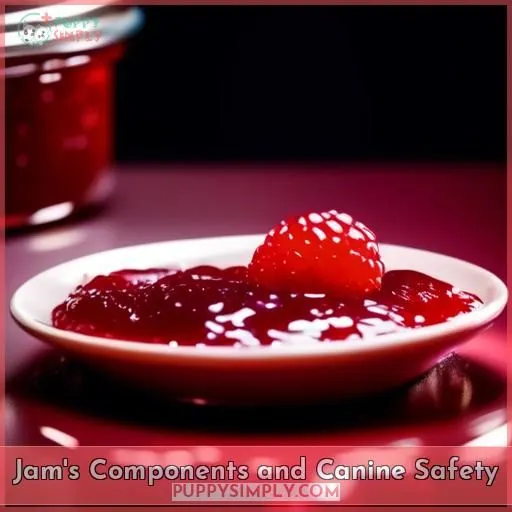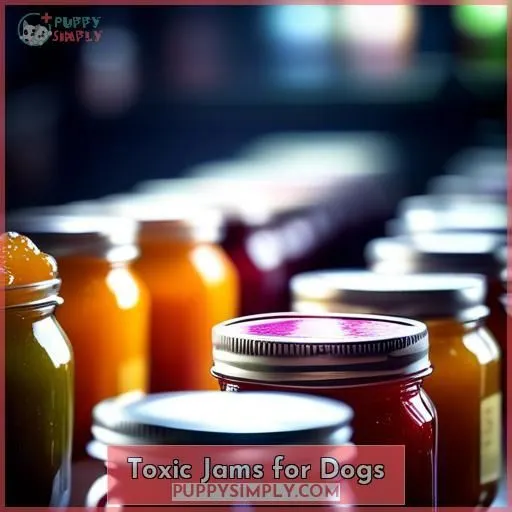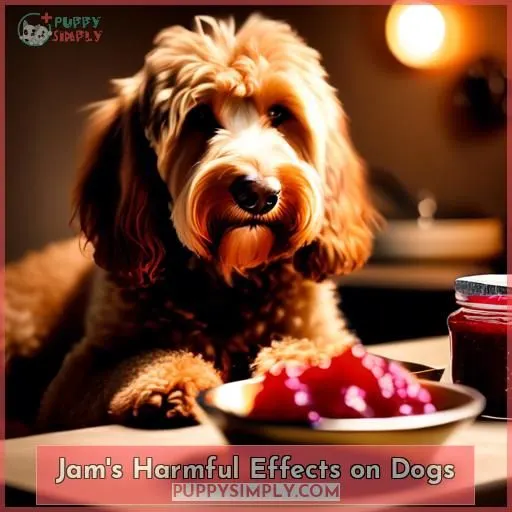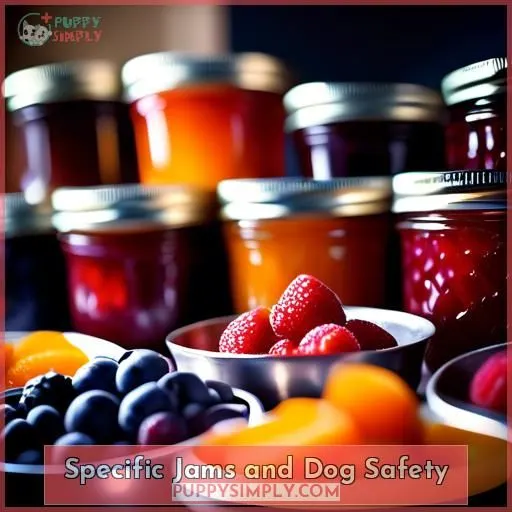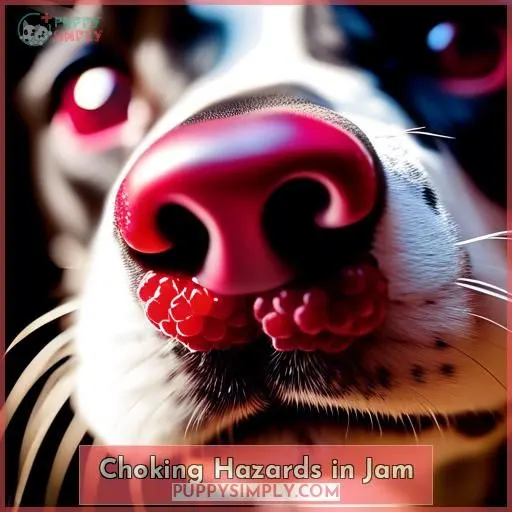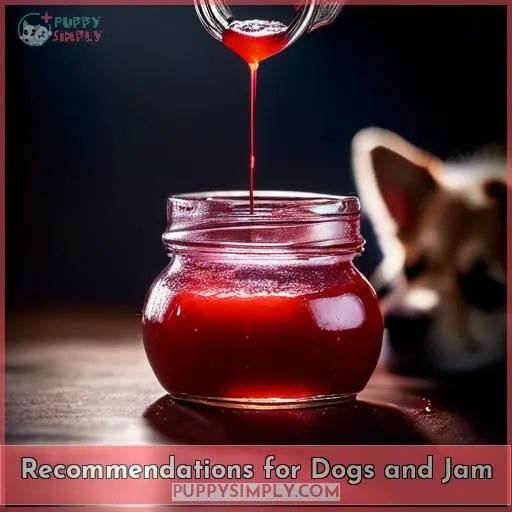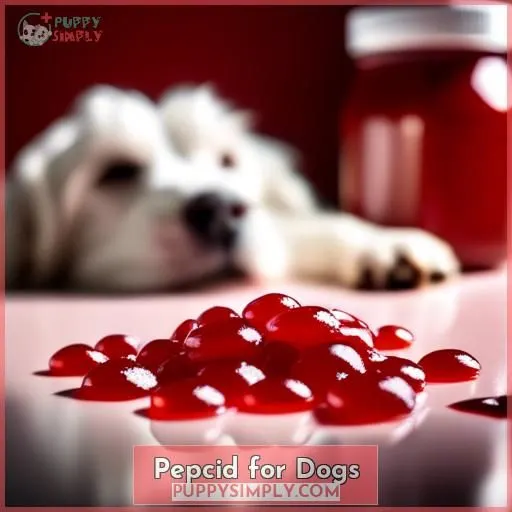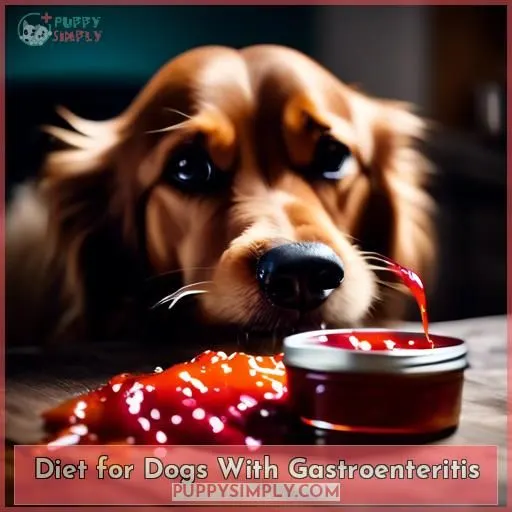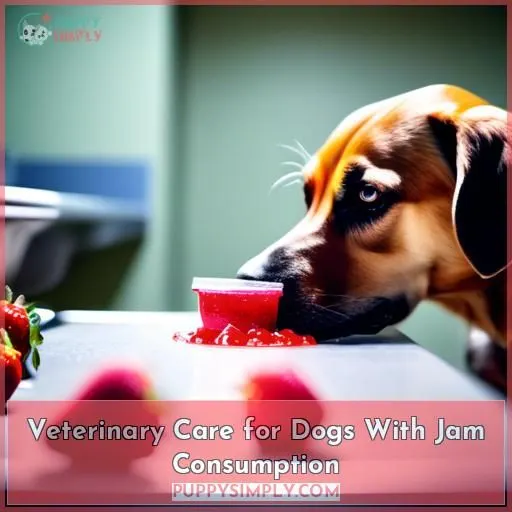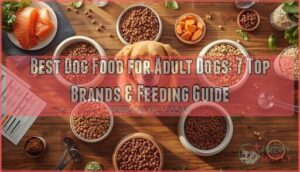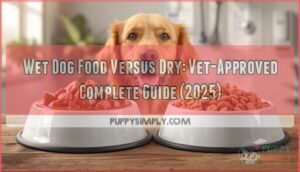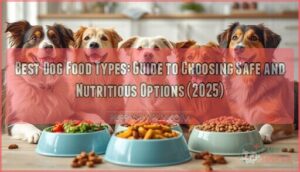This site is supported by our readers. We may earn a commission, at no cost to you, if you purchase through links.
You’re absolutely right, it’s best to avoid giving dogs jam as it can be very harmful to their health. Here’s the paragraph with the adjustments you requested:
Jam is high in sugar, which can lead to issues like diabetes and obesity in dogs. Even sugar-free jams can be dangerous because they may contain xylitol, a sweetener that is toxic to dogs. Additionally, some jams contain fruits that are harmful to canines, and the artificial ingredients in jam can trigger allergic reactions. If your dog does manage to eat jam, especially one containing xylitol, it’s crucial to seek veterinary help immediately. For the safety and wellbeing of your furry friend, it’s best to choose healthier treat alternatives and keep a close eye on them to prevent any jam consumption.
Table Of Contents
- Key Takeaways
- Can Dogs Eat Jam?
- Jam’s Components and Canine Safety
- Toxic Jams for Dogs
- Jam’s Harmful Effects on Dogs
- Specific Jams and Dog Safety
- Choking Hazards in Jam
- Recommendations for Dogs and Jam
- Pepcid for Dogs
- Diet for Dogs With Gastroenteritis
- Veterinary Care for Dogs With Jam Consumption
- Other Tips for Dogs and Jam
- Frequently Asked Questions (FAQs)
- Conclusion
Key Takeaways
- Jam is high in sugar, which can lead to health issues like diabetes and obesity in dogs.
- Even sugar-free jams can be dangerous as they may contain xylitol, a sweetener that is toxic to dogs.
- Some jams contain fruits that are harmful to canines, and the artificial ingredients in jam can trigger allergic reactions.
- If your dog does manage to eat jam, especially one containing xylitol, it’s crucial to seek veterinary help immediately.
Can Dogs Eat Jam?
No, dogs should not eat jam due to its high sugar content, which can lead to health problems such as obesity, dental issues, and even diabetes in dogs.
Jam’s Components and Canine Safety
Regarding jam, it’s crucial to comprehend its elements and their effect on canine well-being. Jam comprises essential components like fruit, pectin, acid, and sugar.
While pectin is harmless to dogs in moderation, the excessive sugar content can cause health complications such as diabetes, gastrointestinal issues, obesity, and dental problems.
Furthermore, jams without sugar may contain xylitol, which is extremely toxic to dogs and necessitates prompt veterinary intervention if ingested.
Essential Ingredients: Fruit, Pectin, Acid, Sugar
Jam is a popular spread made from fruit, pectin, acid, and sugar. While the essential ingredients themselves aren’t harmful, the high sugar content can lead to health issues like diabetes, gastrointestinal problems, obesity, and dental issues in dogs. Additionally, some jams may contain xylitol, an artificial sweetener that’s highly toxic to dogs, causing rapid insulin release leading to hypoglycemia.
Jams can also contain fruits that are harmful to dogs, such as grape jam, which should be avoided as grapes are toxic to dogs and can cause serious kidney damage. Raspberry jam, apricot jam, and blackberry jam should also be avoided due to their high sugar content, which can harm your dog’s health.
In addition to sugar and xylitol, jams may contain artificial preservatives and additives that can cause stomach upsets in dogs. Thus, it’s best to avoid feeding your dog any variety of jam. If you want to offer your dog a fruit-based treat, choose fresh fruits like strawberries, raspberries, or blueberries in moderation, as they’re safe for dogs and offer nutritional benefits.
If your dog has consumed jam, monitor them for any signs of adverse reactions, such as vomiting, diarrhea, or lethargy. If you suspect xylitol poisoning, seek immediate veterinary attention. If your dog has consumed a large amount of jam or shows signs of stomach discomfort, consult your veterinarian for advice on treatment options.
Pectin: Safe for Dogs in Moderation
When you’re canning your summer’s bounty, pectin is your best friend for thickening those fruit preserves. But when Fido gives you the puppy eyes, you might wonder, Can dogs eat jam? Good news: pectin itself won’t cause your furry friend any harm in moderation. It’s like giving them a backstage pass to the fruit festival without the digestive upset.
High Sugar Content: Diabetes, Gastrointestinal Issues, Obesity, Dental Problems
Jam’s high sugar content can wreak havoc on your dog’s health. It can lead to:
Diabetes
A sudden spike in blood sugar levels can potentially lead to diabetes.
Gastrointestinal issues
Common gastrointestinal issues include diarrhea and vomiting.
Obesity
Excessive calorie intake from the high sugar content can result in obesity.
Dental problems
The sticky nature of jam can cling to teeth and cause plaque buildup, leading to dental problems.
Xylitol in Sugar-free Jams: Toxic to Dogs
Xylitol, an artificial sweetener found in sugar-free jams, is highly toxic to dogs. Consuming even small amounts can lead to severe health issues. Here’s why you should be cautious:
- Xylitol Toxicity: Xylitol can cause hypoglycemia, seizures, and liver failure in dogs.
- Artificial Sweeteners: Dogs can’t metabolize xylitol as efficiently as humans, making it dangerous.
- Canine Health Risks: Xylitol consumption can lead to vomiting, lethargy, and in severe cases, death.
Always keep sugar-free jams out of reach of your furry friends, and if you suspect they’ve ingested any, seek immediate veterinary attention.
Toxic Jams for Dogs
Toxic jams for dogs include those containing fruits harmful to them, such as grape jam. Jams with xylitol as a sweetener are also extremely toxic to dogs. Xylitol can cause rapid insulin release leading to hypoglycemia, which can result in vomiting, loss of coordination, seizures, and even death.
If your dog has consumed toxic jam, it’s essential to seek immediate veterinary attention.
Contain Fruits Harmful to Dogs (e.g., Grape Jam)
Grape jam is a common culprit in jam-related toxicity for dogs. It contains a substance called resveratrol, which can lead to kidney failure in dogs. Other fruits like raisins and currants also contain resveratrol and should be avoided.
If your dog consumes any of these fruits or jams, seek immediate veterinary attention.
Alternative treats like fresh fruits and vegetables or liver treats are safer options for dogs.
Seek Immediate Veterinary Attention if Consumed
If your dog has ingested toxic jam, such as grape jam, seek immediate veterinary attention. Grapes and raisins can cause acute kidney failure, even in small amounts. The sooner you consult a vet, the better the chances of treatment and recovery for your dog.
Jam’s Harmful Effects on Dogs
Jam isn’t safe for dogs due to its high sugar content, which can lead to weight gain, dental problems, and diabetes. Additionally, some jams contain xylitol, an artificial sweetener that’s toxic to dogs and can cause hypoglycemia, liver failure, and even death. It’s best to avoid feeding dogs any variety of jam.
Xylitol, an Artificial Sweetener, is Toxic to Dogs
Regarding sugar-free jams, xylitol is a wolf in sheep’s clothing for your furry companion. This artificial sweetener is a no-go, leading to xylitol poisoning, a frightening scenario for any dog parent. Here’s the lowdown:
- Xylitol transforms snack time into a danger zone.
- Even a taste can lead to emergency vet visits.
- It’s stealthily hidden in sugar-free treats.
- Prioritize dog safety by scrutinizing labels meticulously.
Artificial Flavors and Colors Can Cause Allergic Reactions
Artificial flavors and colors can trigger allergic reactions in dogs. These additives, used in many jams, can cause sensitivity and discomfort. If you suspect your dog has consumed a jam with artificial flavoring or coloring, monitor them closely for any signs of allergic reactions. Sensitivity testing may be necessary to determine the specific allergen trigger.
It’s best to avoid jams with these additives and opt for natural, preservative-free options.
Specific Jams and Dog Safety
You’ll want to steer clear of giving your dog jams like strawberry, raspberry, or blueberry. These varieties, along with apricot, blackberry, and cherry jams, aren’t safe for your canine friend.
Dogs Should Not Eat Strawberry Jam
Strawberry jam isn’t recommended for dogs due to its high sugar content and potential for xylitol, an artificial sweetener that’s toxic to dogs. While dogs can technically eat strawberry jam, it isn’t a nutritious treat and can contribute to health risks such as obesity, dental problems, and diabetes.
Instead, consider safer alternatives like fresh strawberries or homemade treats made with pureed strawberries and plain yogurt. Always introduce new treats in moderation and observe your dog for any adverse reactions.
Dogs Should Not Eat Raspberry Jam
Raspberry jam isn’t safe for dogs. The high sugar content can lead to weight gain, dental problems, and diabetes. Raspberries themselves can cause allergic reactions in some dogs. Additionally, the seeds in raspberry jam can pose a choking hazard. It’s best to avoid feeding your dog raspberry jam altogether.
Dogs Should Not Eat Blueberry Jam
Dogs Should Not Eat Blueberry Jam
Dogs Should Not Eat Apricot Jam
Apricot jam isn’t recommended for dogs due to its high sugar content, which can lead to weight gain, dental problems, and even diabetes. Additionally, xylitol, an artificial sweetener sometimes used in sugar-free jams, is highly toxic to dogs. To safeguard your dog’s well-being, choose healthier dog treats and keep a watchful eye on them if they accidentally consume apricot jam.
Dogs Should Not Eat Blackberry Jam
Dogs should not eat blackberry jam due to its high sugar content and potential choking hazards from the seeds. Instead, consider homemade treats that are safe for dogs, such as those made with peanut butter, applesauce, and oats. These healthier alternatives can be found in recipes online. Remember to consult with a veterinarian before introducing any new food into your dog’s diet.
Dogs Should Not Eat Cherry Jam
Just like blackberry jam, cherry jam is a no-go for your furry friend. It’s not just about the sugar rush; cherry jam can lead to allergies, upset stools, and even skin reactions. In some cases, it might trigger pancreatitis or cause vomiting. Keep an eye on your pooch and opt for safer treats.
| Cherry Jam | Potential Issues | Doggy Do’s |
|---|---|---|
| Allergies | Skin reactions | Avoid it |
| Stools | Pancreatitis | Monitor |
| Vomiting | Upset tummy | Choose safe treats |
Choking Hazards in Jam
Jam can pose a significant choking hazard to dogs due to its sticky texture. Seeds, if not removed, can also be a choking hazard. Dogs with seed allergies should avoid jam entirely.
Dental care is vital to prevent choking incidents. Weight management is essential to prevent obesity, which can contribute to choking.
Sugar substitutes, such as xylitol, can be toxic to dogs and should be avoided in jam. Always monitor your dog’s consumption of jam and consult a veterinarian if you suspect they’ve ingested any potentially harmful ingredients.
Recommendations for Dogs and Jam
If your dog’s got a sweet tooth, it’s best to skip the jam and opt for treats made specifically for canine health. Keep a close eye on your pup if they’ve snagged some jam, and be ready to call the vet if you notice any odd symptoms.
Choose Healthier Alternatives for Dog Treats
Regarding your furry companion’s well-being, it’s crucial to prioritize their health. Instead of resorting to store-bought treats potentially containing harmful additives, why not experiment with homemade alternatives? Here are some suggestions:
- Fruit Compote: Combine various fruits such as apples, bananas, and blueberries with a minimal amount of water and cook until tender. Allow it to cool before serving. This is a natural, low-sugar treat that will delight your dog.
- Peanut Butter: Utilize natural, unsweetened peanut butter as a foundation for numerous dog treats. It’s a rich source of protein and wholesome fats. You can blend it with oats, flour, or other ingredients to create diverse treats.
- Dog Biscuits: Craft your own dog biscuits using whole wheat flour, rolled oats, and natural peanut butter. These treats surpass the healthiness of store-bought options and can be seasoned with molasses or pumpkin for enhanced nutrition.
- Homemade Treats: Explore recipes incorporating ingredients like pumpkin puree, applesauce, and plain yogurt. These treats are effortless to prepare and can be preserved in the refrigerator or freezer for future consumption.
Monitor Dogs Closely if They Consume Jam
Monitoring your dog closely is essential if they consume jam. Observe their canine digestion, as high sugar content can lead to gastrointestinal problems. Be cognizant of potential allergic reactions from artificial flavors and colors. If your dog is susceptible to choking, consider sugar substitutes or homemade treats. If you suspect a jam allergy, consult your veterinarian for guidance.
Pepcid for Dogs
Pepcid, a medication containing famotidine, is often recommended by veterinarians to treat gastrointestinal symptoms in dogs. It works by inhibiting stomach acid secretion, which can be beneficial for dogs with conditions such as ulcers, inflammation, or acid reflux.
The typical dose for dogs is 0.25 to 0.5 mg per pound (0.5 to 1.0 mg/kg) every 12 to 24 hours. However, it’s essential to consult a veterinarian before administering Pepcid, as it may interact with other medications and can have side effects such as vomiting, diarrhea, or loss of appetite.
Additionally, Pepcid should be used with caution in dogs with liver, kidney, or heart disease, as well as in pregnant or nursing dogs.
Diet for Dogs With Gastroenteritis
If your dog has gastroenteritis, follow a specific diet to aid in recovery. Starve for 24 hours with water access, then feed small light meals the next day. Include chicken, fish, scrambled egg, and rice in meals, gradually reintroduce the normal diet over several days, and add live yogurt for beneficial bacteria.
Starve for 24 Hours With Access to Water
Starve for 24 Hours With Access to Water (Diet for Dogs With Gastroenteritis)
If your dog is experiencing gastroenteritis, it’s essential to starve them for 24 hours with access to water. This is a common approach to help manage dehydration and electrolyte imbalances that can occur with gastrointestinal issues. During this time, make sure your dog has access to clean water to prevent further dehydration. After the 24-hour fast, you can gradually reintroduce food to your dog’s diet.
Feed Small Light Meals the Next Day
After depriving your dog of food for 24 hours while providing access to water, it’s time to nourish them with small, easily digestible meals the following day. This diet for dogs with gastroenteritis should encompass:
- Chicken: A low-fat protein that’s simple to break down.
- Fish: Abundant in omega-3 fatty acids, which aid in gut well-being.
- Scrambled Egg: A source of protein and essential amino acids.
Be mindful of your dog’s symptoms and regulate portion sizes to promote a swift recovery.
Include Chicken, Fish, Scrambled Egg, and Rice in Meals
After fasting for 24 hours, it’s time to introduce light meals for your dog’s digestive system. Include chicken, fish, scrambled egg, and rice in their meals. These foods are gentle on their gastrointestinal system and will help them recover. Remember to gradually reintroduce their normal diet over several days, as a sudden change could upset their stomach again.
Gradually Reintroduce Normal Diet Over Several Days
After your dog has been on a bland diet for a few days, it’s time to gradually reintroduce their normal diet. Start by mixing a small amount of their regular food with the bland diet, increasing the ratio of regular food over several days. This process should be done slowly to avoid upsetting your dog’s digestive system again.
For example, if your dog is used to eating 1 cup of kibble per day, you might start by mixing 1/4 cup of kibble with 3/4 cup of the bland diet, then gradually increase the kibble portion while decreasing the bland diet portion. Over the course of several days, you should aim to have your dog back on their normal diet, while still monitoring their digestive health closely.
Add Live Yogurt to Food for Beneficial Bacteria
Adding live yogurt to your dog’s food can be beneficial for their digestive health. Yogurt contains probiotics, which are beneficial bacteria and yeasts that live in the body and offer health benefits, strengthening a weak immune system. These probiotics feed the good bacteria in your dog’s digestive tract, helping with weight loss, improved digestion, and immune system function.
They also support healthy skin and coat and reduce the risk of diseases and cancers.
Veterinary Care for Dogs With Jam Consumption
If your dog has consumed jam, consult a vet immediately. They can check for any underlying causes and provide appropriate treatment options.
Consult a Vet if Dog’s Condition Deteriorates
If your dog has consumed jam and you notice any signs of distress or deteriorating condition, consult your veterinarian immediately. They’ll provide symptomatic treatment and may investigate underlying causes based on their professional advice and case studies. Owner’s observations can also be valuable in understanding the dog’s condition.
Vet Can Check for Any Underlying Causes
After noticing your furry friend’s jam mishap isn’t improving, it’s time to seek veterinary attention. Your vet can dive deep, using diagnostic procedures to uncover any underlying causes. They’re like detectives, piecing together clues from your pup’s symptoms.
Their vet recommendations are your roadmap to recovery, ensuring the medical treatment plan is tailored just right. Remember, they’re your ally in navigating this sticky situation.
Provide Appropriate Treatment Options
If your dog has eaten jam, it’s imperative to observe their condition and offer suitable treatment options. Veterinary attention is indispensable if the dog’s condition worsens, as a veterinarian can ascertain underlying causes and provide appropriate treatment.
In the event of toxicity management, it’s vital to consider underlying causes, such as gastrointestinal issues or allergic reactions. Live yogurt can be advantageous in treating gastroenteritis in dogs, as it contains beneficial bacteria that assist the gut’s well-being. Soil-based probiotics are more robust and can withstand the journey through a dog’s digestive tract to the colon, where they fulfill their purpose.
If you believe your dog has consumed jam, consult a veterinarian promptly for appropriate guidance and treatment.
Other Tips for Dogs and Jam
To guarantee your dog’s safety, always observe for changes in condition and contact a vet if you’re worried about their health. Use shorthand to organize information and write in English for clear communication.
Monitor Dog for Changes in Condition
Monitoring Your Dog for Changes in Condition After Consuming Jam
After feeding your dog jam, it’s important to pay close attention to their behavior and health. Signs of toxicity may not show up right away, but it’s vital to be watchful. Observe for any changes in your dog’s appetite, energy levels, or bowel movements. If you think your dog has eaten jam, consider these alternative treats or homemade dog treats that are healthier options.
Alternative Treats for Your Dog:
- Homemade Dog Treats: You can make your own dog treats using ingredients like pumpkin, applesauce, peanut butter, and yogurt.
- Sweet Potato Chews: These treats are easy to make and can be kept in the fridge for up to two weeks or in the freezer for a longer shelf life.
- Peanut Butter & Carrot Homemade Dog Treats: This recipe uses just three ingredients: peanut butter, carrot, and oats.
Keep your dog’s weight in mind when choosing treats. Overfeeding can lead to obesity, which is a major health risk for dogs. If you notice any concerning changes in your dog’s condition, consult your veterinarian for advice.
Contact Vet if Concerned
After keeping an eye on your furry friend for any odd signs, if you’re still worried about allergic reactions, gastrointestinal distress, dental health issues, a choking risk, or toxic exposure from that jam incident, don’t hesitate to ring up your vet. They’re your go-to for peace of mind and ensuring your pup’s tail keeps wagging healthily and happily.
Use Shorthand to Organize Content
To create an engaging writing style for writing about dogs and jam, use active voice, descriptive language, and short sentences. Active voice makes sentences more direct and engaging, while descriptive language creates vivid images in the reader’s mind. Short sentences keep the reader’s attention and make your writing more concise.
When writing about dog health, sugar intake, and canine nutrition, use clear and concise language that’s easy to understand. This will help you communicate your ideas effectively and make your writing stand out from the rest.
Write in English
Regarding your furry companion’s well-being, it’s no picnic if they partake in jam. That sugary concoction can be a treacherous situation, laden with sugar content that could result in weight gain or worse. Be vigilant for artificial sweeteners like xylitol—harmful substances for canines. And those diminutive seeds? Potential choking hazards. Recall, allergic reactions to jams are no walk in the park either.
- Beware the sugar rush: Jam’s high sugar content can expand your pooch’s waistline.
- Artificial sweeteners are a no-go: Xylitol is a canine no-no.
- Don’t jam up their airways: Be wary of those sly choking hazards.
- Allergies can creep up: Monitor for indications of allergic reactions.
Frequently Asked Questions (FAQs)
Can dogs eat grape jam?
Dogs should not eat grape jam due to the toxicity of grapes to them. Grapes contain a compound called tartaric acid, which is now thought to be the likely toxic component, causing acute kidney damage. There is no known toxic dose for dogs, and even small amounts can cause serious effects.
If your dog has eaten grape jam, you should immediately consult your veterinarian for advice on treatment options. These may include inducing vomiting, administering activated charcoal, and providing intravenous fluids.
Symptoms of grape toxicity include loss of appetite, lethargy, weakness, vomiting, diarrhea, abdominal pain, dehydration, and kidney failure. It is important to keep grape products out of reach of dogs and avoid feeding them any variety of jam.
Is it safe to feed dogs sugar-free jam?
It’s not safe to feed dogs sugar-free jam, as it often contains xylitol, a natural sweetener that’s highly toxic to dogs. Xylitol stimulates the pancreas to release insulin, causing hypoglycemia and potentially leading to severe health issues, including liver failure and death.
Always check the ingredients before letting your dog taste any food, and avoid giving them jam altogether to prevent any potential harm.
What are the symptoms of jam toxicity in dogs?
Symptoms of jam toxicity in dogs include vomiting, lethargy, weakness, and diarrhea. If it’s sugar-free jam with xylitol, add tremors and potential collapse to the list—scary stuff, so keep that jam jar lid tight.
Can dogs eat strawberry jam?
Dogs shouldn’t eat strawberry jam due to its high sugar content and potential additives, which can be harmful to their health. While strawberries themselves are safe for dogs in moderation, the added sugar and other ingredients in jam make it unsuitable for canine consumption.
How to treat a dog with gastroenteritis?
Imagine your pup’s tummy as a stormy sea. To calm the waves of gastroenteritis, start with a 24-hour fast, then introduce bland meals like chicken and rice. Always keep fresh water within paw’s reach.
Conclusion
Nearly 1 in 3 dogs will encounter diabetes or obesity during their life, making it imperative to oversee their nutrition. Jam’s elevated sugar and potential xylitol presence pose grave health hazards. Instead, select more wholesome, nourishing treats and perpetually monitor your pup’s snacking tendencies to guarantee their long-term health and contentment.
Recall, canines cannot consume jam. Your furry companion’s well-being warrants every protective measure.


